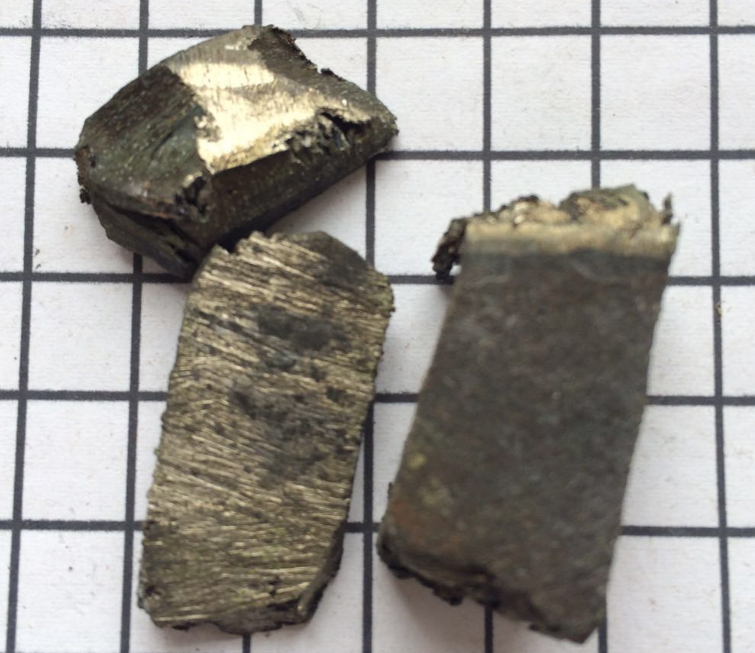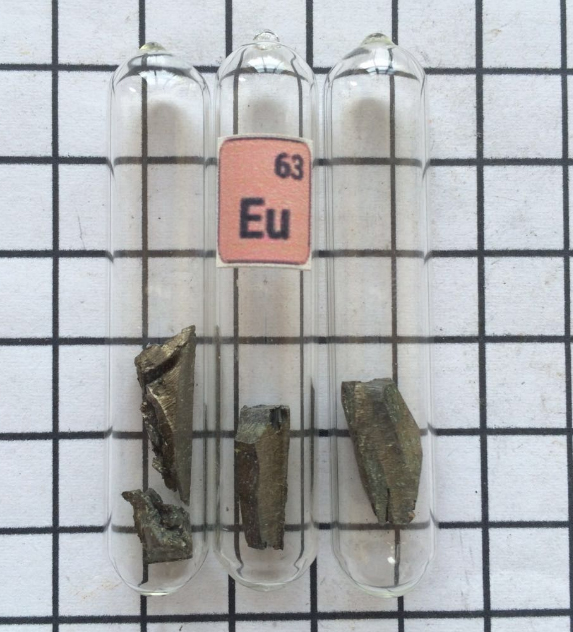Europium metal
Europium is the most active metal among the silver white rare
earths. It is easy to oxidize when exposed to air and should be immersed
in kerosene. Or vacuum-sealed and preserved. Used as a refined alloy to
make lamps, fluorescent screens and organic reagent additives
Rare earth europium is a lively and soft metal, and its melting point
and boiling point are also very low among rare earth metals. Europium is
very lively, it will be quickly oxidized into a pile of powder in the
air, it will burn when heated, and it will react violently with cold
water. The metal europium has a low content in the crust and is
difficult to preserve, so the price is relatively high. The method of
reducing europium oxide is commonly used to prepare metal europium,
which is separated and purified by vacuum distillation. Some compounds
of Europium have fluorescent properties. When used in phosphors and
display screens, they must be stored in an inert medium or a vacuum
container.
Application areaedit
Used as the phosphor of color TV sets, it has important applications in
laser materials and atomic energy industry.
Europium oxide is mostly used in phosphors. Eu3+ is used as an activator
for red phosphors, and Eu2+ is used for blue phosphors. Y2O2S: Eu3+ is
the best phosphor for luminous efficiency, coating stability, and
recycling cost. Coupled with improvements in technologies such as
improving luminous efficiency and contrast, it is being widely used.
In recent years, europium oxide has also been used in stimulated
emission phosphors in new X-ray medical diagnostic systems [8]. Europium
oxide can also be used to make colored lenses and optical filters, used
in magnetic bubble storage devices, and can also be used in nuclear
reactor control materials, shielding materials and structural materials.
Because its atoms can absorb more neutrons than any other element, it is
often used as a neutron-absorbing material in atomic reactors. In
addition, it can be used as phosphors for color TVs. These phosphors
emit a shining red color and are used to make TV phosphor screens; laser
materials, etc.
Rare earth europium complex is a red fluorescent material with high
luminous quantum efficiency of organic compounds and good stability of
inorganic compounds, and has good application prospects.
.
.


Europium is the most active metal among the silver white rare
earths. It is easy to oxidize when exposed to air and should be immersed
in kerosene. Or vacuum-sealed and preserved. Used as a refined alloy to
make lamps, fluorescent screens and organic reagent additives
Rare earth europium is a lively and soft metal, and its melting point
and boiling point are also very low among rare earth metals. Europium is
very lively, it will be quickly oxidized into a pile of powder in the
air, it will burn when heated, and it will react violently with cold
water. The metal europium has a low content in the crust and is
difficult to preserve, so the price is relatively high. The method of
reducing europium oxide is commonly used to prepare metal europium,
which is separated and purified by vacuum distillation. Some compounds
of Europium have fluorescent properties. When used in phosphors and
display screens, they must be stored in an inert medium or a vacuum
container.
Application areaedit
Used as the phosphor of color TV sets, it has important applications in
laser materials and atomic energy industry.
Europium oxide is mostly used in phosphors. Eu3+ is used as an activator
for red phosphors, and Eu2+ is used for blue phosphors. Y2O2S: Eu3+ is
the best phosphor for luminous efficiency, coating stability, and
recycling cost. Coupled with improvements in technologies such as
improving luminous efficiency and contrast, it is being widely used.
In recent years, europium oxide has also been used in stimulated
emission phosphors in new X-ray medical diagnostic systems [8]. Europium
oxide can also be used to make colored lenses and optical filters, used
in magnetic bubble storage devices, and can also be used in nuclear
reactor control materials, shielding materials and structural materials.
Because its atoms can absorb more neutrons than any other element, it is
often used as a neutron-absorbing material in atomic reactors. In
addition, it can be used as phosphors for color TVs. These phosphors
emit a shining red color and are used to make TV phosphor screens; laser
materials, etc.
Rare earth europium complex is a red fluorescent material with high
luminous quantum efficiency of organic compounds and good stability of
inorganic compounds, and has good application prospects.
.
.

|

|
